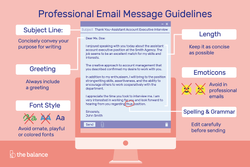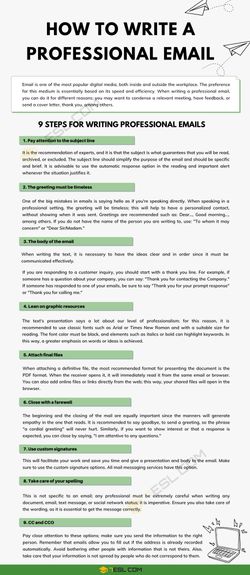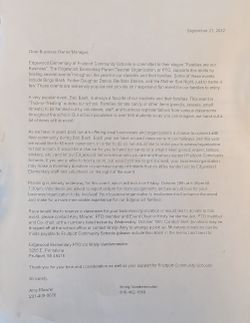Oct 1, 2022
How to write a professional email


Professional Email Address
When you receive an email from an unknown sender, there’s always a moment of hesitation when you think: “Is it spam?”
If you want to give your emails a chance to be opened, the first thing you should do, before you even write a professional message for the first time, is create a professional email address on your business domain.
1. Subject Line
Start a business email with a good subject line — it’s the first and most important ingredient of any email you create.
A good subject line should always be concise and summarize the reason for sending the message or clearly present the goal of communication.
Subject line
examples:
Requested documents (not very good)
Requested documents for shareholder meeting (informative and complete)
Greeting
Why Email Opening Greetings Are Important
How you greet people in an email can set the tone for all your future conversations. It can mean the difference between landing your dream job, closing a deal, or ending up on a blacklist. People’s perceptions of you are important. They tell the recipients who you are and what kind of relationships you expect to build.
Greeting
An email is pretty similar to a regular meet-up in which you greet someone before saying anything else.
How you greet a recipient depends on your relationship with the person.
If you are sending an email to your colleague, you may use a more informal salutation and greet the person by saying “Hi” or “Hello,” followed by his/her first name.
Greeting
If the relationship is formal, a more appropriate greeting would be to use the person’s family name, for example, “Dear Mr. Smith.”
To whom it may concern is also commonly used when you are unsure of the recipient.
Greeting
First Contact vs. Prior Correspondence
First-contact or cold emails require a dose of formality, especially in a professional setting. If you use an informal greeting in your first email, you risk sounding disrespectful. Avoid using first names or nicknames and trying to be witty with your greeting — unless, of course, you are applying for a job that demands that dose of creativity.
Greeting
When you’ve had prior communication with the person you’re emailing, you can consider using their first name or a nickname, especially if they’ve used it in their email signature. This can show that your relationship is evolving and that you are genuinely interested in getting to know the person.
Greeting
What to Avoid
You can and should adapt your tone based on your recipient and situation. However, there are certain openers you should avoid at all costs.
The biggest mistake you can make is misspelling the recipient’s name. Also, if a person has an honorific attached to their name, omitting it is another sign of disrespect.
Greeting
The next thing you need to be cautious about is being overly informal. Some people may appreciate your personalized attempt to connect, but most won’t.
It’s easy to start an email with “To whom it may concern” or “Dear sir/madam,” but it can make you look lazy. Whenever possible, try to address specific people.
Greeting
Sounding sarcastic can seem witty, but few will understand your intentions the right way. The same is often true for full-blown jokes. Avoid sounding offensive or annoying.
Finally, asking personal questions may not be received well. Instead, use a statement as an alternative. For example, you can replace “How’s your health been lately?” with “I hope you’re doing well.”
Body
3. Body
This section is pretty similar to your real-life conversations.
If you don’t know the person, first explain who you are and how you found him/her.
You can start by saying, “I am writing to enquire about …” or “I am writing in reference to… .”
If you make your purpose clear early on, there will be less need for clarification later on in your business communication.
Body
The body should contain detailed information but also be clear and concise.
Make the whole message as short as it can be while conveying the essence of what you are saying. Avoiding long reads in email communication saves you time and makes it more likely that the recipient will read your message till the end.
In the following example, all the essential information is written in short sentences and takes only three paragraphs to read. All the details are left for the second email if the recipient is interested in continuing the conversation.

Closing
4. Closing
How you end a business email can also affect the success of your future conversations.
The best way to end a business email is with a call-to-action that would prompt the recipient to make the next move. It could be something as simple as, “Look forward to hearing from you.”
Closing
5. Signature
This last element is used to identify yourself. In addition to your first and last name, it’s also good to include the following details:
Your position in the company or your professional job title;
Your affiliate company or organization;
Your contact information: phone number with a prefix if you work internationally, company or personal website, office address, social media links (but only what coincides with your professional goals); and
A photo of you or the company logo.
Closing
Also, it’s good manners to use transitional phrases between your closing and the signature. These include:
Best regards,
Sincerely, and
Thank you.

By undefined
21 notes ・ 195 views
English
Upper Intermediate